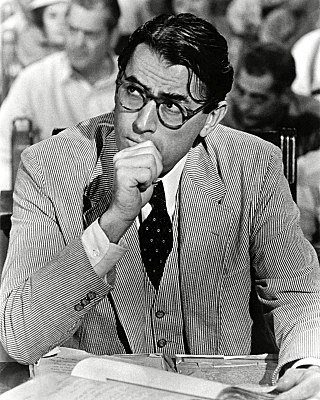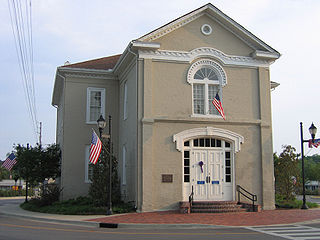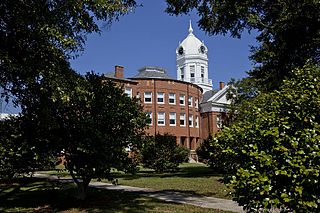
To Kill a Mockingbird is a novel by the American author Harper Lee. It was published in July 1960 and became instantly successful. In the United States, it is widely read in high schools and middle schools. To Kill a Mockingbird has become a classic of modern American literature; a year after its release, it won the Pulitzer Prize. The plot and characters are loosely based on Lee's observations of her family, her neighbors and an event that occurred near her hometown of Monroeville, Alabama, in 1936, when she was ten.

Monroe County is a county located in the southwestern part of the U.S. state of Alabama. As of the 2020 census, the population was 19,772. Its county seat is Monroeville. Its name is in honor of James Monroe, fifth President of the United States. It is a dry county, in which the sale of alcoholic beverages is restricted or prohibited, but Frisco City and Monroeville are wet cities.

Monroeville is the county seat of Monroe County, Alabama, United States. At the 2020 census its population was 5,951.

Nelle Harper Lee was an American novelist whose 1960 novel To Kill a Mockingbird won the 1961 Pulitzer Prize and became a classic of modern American literature. She assisted her close friend Truman Capote in his research for the book In Cold Blood (1966). Her second and final novel, Go Set a Watchman, was an earlier draft of Mockingbird, set at a later date, that was published in July 2015 as a sequel.

To Kill a Mockingbird is a 1962 American coming-of-age legal drama crime film directed by Robert Mulligan starring Gregory Peck and Mary Badham, with Phillip Alford, John Megna, Frank Overton, James Anderson, and Brock Peters in supporting roles. It marked the film debut of Robert Duvall, William Windom, and Alice Ghostley. Adapted by Horton Foote, from Harper Lee's 1960 Pulitzer Prize–winning novel of the same name, it follows a lawyer (Peck) in Depression-era Alabama defending a black man (Peters) charged with rape while educating his children against prejudice.

Atticus Finch is a fictional character and the protagonist of Harper Lee's Pulitzer-Prize-winning novel of 1960, To Kill a Mockingbird. A preliminary version of the character also appears in the novel Go Set a Watchman, written in the mid-1950s but not published until 2015. Atticus is a lawyer and resident of the fictional Maycomb County, Alabama, and the father of Jeremy "Jem" Finch and Jean Louise "Scout" Finch. He represents the African-American man Tom Robinson in his trial where he is charged with rape of Mayella Ewell. Through his unwavering dedication to upholding justice and fighting for what is right, Atticus becomes an iconic symbol of moral integrity and justice. Lee based the character on her own father, Amasa Coleman Lee, an Alabama lawyer, who, like Atticus, represented black defendants in a highly publicized criminal trial. Book magazine's list of The 100 Best Characters in Fiction Since 1900 names Finch as the seventh best fictional character of 20th-century literature. In 2003, the American Film Institute voted Atticus Finch, as portrayed in an Academy Award-winning performance by Gregory Peck in the 1962 film adaptation, as the greatest hero of all American cinema. In the 2018 Broadway stage play adapted by Aaron Sorkin, Finch has been portrayed by various actors including Jeff Daniels, Ed Harris, Greg Kinnear, Rhys Ifans, and Richard Thomas.

The Old Shelby County Courthouse, also known as Columbiana City Hall, is a defunct courthouse in Columbiana, Alabama. It was built in 1854. It served as the courthouse for Shelby County until 1906 when a larger court facility was built. It also served as Columbiana's city hall. Since 1982, it has housed the Shelby County Museum and Archives and its operator, the Shelby County Historical Society.

The Old Courthouse, Warren County, stands prominently on a hill in Vicksburg, Mississippi, and was a symbol of Confederate resistance during the Siege of Vicksburg. It was designated a National Historic Landmark in 1968 and a Mississippi Landmark in 1986. The landmarked area comprises the entire Courthouse Square, which includes the courthouse and four attached buildings that were originally cistern houses for catching rainwater to fight fires, but these were later converted into offices. Since 1948, it has served as The Old Courthouse Museum, focused on local history and the Confederacy.

The Dallas County Courthouse, built in 1892 of red sandstone with rusticated marble accents, is a historic governmental building located at 100 South Houston Street in Dallas, Texas. Also known as the Old Red Courthouse, it became the Old Red Museum, a local history museum, in 2007. In 2021, it was announced that the Old Red Museum would be moving out and the building is being returned into a hall of justice. The Texas Fifth Circuit Court of Appeals is moving into Old Red (2024).
William Augustus Edwards, also known as William A. Edwards was an Atlanta-based American architect renowned for the educational buildings, courthouses and other public and private buildings that he designed in Florida, Georgia and his native South Carolina. More than 25 of his works have been listed on the National Register of Historic Places.

The Old Greene County Courthouse is a historic courthouse in Eutaw, Alabama, United States. It housed the seat of government for Greene County from 1869 until 1993. The building is a two-story masonry structure in the Greek Revival style with Italianate influences. Architect Clay Lancaster proposed that it may be the last Greek Revival public building to be built in Alabama. It replaced an earlier wooden courthouse on the same site that was built in 1838. The prior courthouse was burned in 1868, in what is considered by most historians to have been a deliberate act of arson that was executed to destroy indictments brought by the recently installed Radical Reconstruction government against local citizens. The fire destroyed paperwork pertaining to some 1,800 suits by freedmen against planters which were about to be acted on. The courthouse was placed on the National Register of Historic Places on March 24, 1971, due to its architectural significance.
A Mississippi Landmark is a building officially nominated by the Mississippi Department of Archives and History and approved by each county's chancery clerk. The Mississippi Landmark designation is the highest form of recognition bestowed on properties by the state of Mississippi, and designated properties are protected from changes that may alter the property's historic character. Currently there are 890 designated landmarks in the state. Mississippi Landmarks are spread out between eighty-one of Mississippi's eighty-two counties; only Issaquena County has no such landmarks.
Amasa Coleman Lee was an American newspaper editor, politician, and lawyer. He was the father of acclaimed novelist Harper Lee.

This is a list of the National Register of Historic Places listings in Monroe County, Alabama.
Monroe County High School is a public high school in Monroeville, Monroe County, Alabama. It is part of the Monroe County School District.

The St. Stephens Courthouse, listed on the National Register of Historic Places as the Washington County Courthouse and also known as the St. Stephens Masonic Lodge, is a historic former courthouse building in St. Stephens, Alabama. The Alabama Legislature authorized construction of the building in 1853 to serve as headquarters for the government of Washington County. The building was completed in 1854 and served as the county courthouse until 1907, when the county seat was moved to Chatom. It served a variety of purposes after that, until being restored in 2000 by the St. Stephens Historical Commission for use as a visitor center and local history museum.

The Monroeville Downtown Historic District is a 40-acre (16 ha) historic district in downtown Monroeville, Alabama. It is centered on the courthouse square and the streets that border it. The streets include Claiborne Street on the south, Alabama Avenue on the east, Pineville Road on the north and Mount Pleasant Avenue on the west. The district includes examples of the Classical Revival, American Craftsman, Moderne, and other residential and commercial architectural styles. It contains 63 structures, with 51 of them listed as contributing buildings. It was added to the National Register of Historic Places on September 16, 2009.

Frederick County Courthouse is a historic county courthouse located at Winchester, Frederick County, Virginia. It was built in 1840, and is a two-story, rectangular, brick building on a stone foundation and partial basement in the Greek Revival style. It measures 50 feet by 90 feet, and features a pedimented Doric order portico and a gabled roof surmounted by a cupola. Also on the property is a contributing Confederate monument, dedicated in 1916, consisting of a bronze statue of a soldier on a stone base.
Andrew J. Bryan (1848–1921) was an architect in the Southern United States, known for his work on county courthouses.
The Monroe Journal is a weekly newspaper from Monroeville, Alabama serving the city and surrounding area.



















